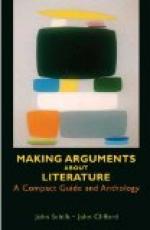A debater uses certain forms which have long been established in parliamentary law. To begin with, he never uses the name of his opponent: if he has to refer to him he refers indirectly in some such form as “the last speaker,” “the first speaker for the affirmative,” “the gentlemen from Wisconsin,” “our opponents,” “my colleague who has just spoken.” This is an inviolable rule of all debating bodies, whether a class in school or college or one of the Houses of Congress.
In a formal debate the subject is stated by the presiding officer, who is usually not one of the judges, and he also introduces each of the speakers in the order agreed on beforehand.
In class debates the subject is usually given out by the instructor, who may assign the speakers, or may call for volunteers, or may let each member of the class take his turn in regular rotation. This distribution will usually work itself out to suit the class and the circumstances. In interscholastic and intercollegiate debates the subject is generally chosen by letting one side offer a number of subjects from which the other selects one. Sometimes the team which does not have the choice of subject has the choice of sides after the other team has picked the subject. In a triangular debate two or three subjects are proposed by each team, and then one is selected by preferential voting of all the contestants, first choice counting three points, second two, and third one. In such a contest each institution has two teams, one of which supports the affirmative, and the other the negative; and the three debates take place on the same day or evening.
In class debates the two sides should unite in preparing an agreed statement of facts, which shall contain so much of the history of the case as is pertinent, facts and issues which it is agreed shall be waived, and a statement of the main issues. Furthermore, it is highly desirable that the sides should submit to each other outline briefs covering the main points of their case. With such preparations there is little probability that there can be any failure to meet. The same preparations would be useful in interscholastic and intercollegiate debates, wherever they are practicable. Anything which leads to a thorough discussion of identical points and to the consequent illumination of the question makes these entertainments more valuable.




